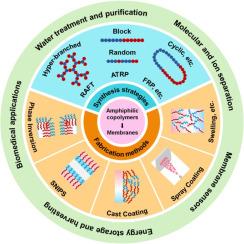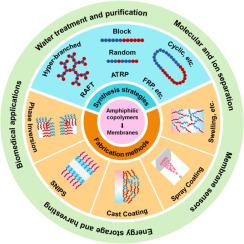基于两性共聚物的先进功能膜
IF 26.1
1区 化学
Q1 POLYMER SCIENCE
引用次数: 0
摘要
具有先进和新颖功能的膜在工业分离、水净化、能量收集和储存、医疗保健、仿生物膜等新兴应用中发挥着重要作用。膜在这些关键应用中的性能主要取决于其与周围离子、分子、颗粒、乳液和生物活性剂的界面相互作用。含有疏水性和亲水性片段的两亲共聚物会自发组装成多相和分层结构,为调节上述紧急应用中使用的膜的表面物理化学特性提供了一种通用解决方案。两亲共聚物的可控合成以及将共聚物制成具有预定性能的膜的方法对其应用至关重要。在这项工作中,我们首先总结了用于合成膜材料的两亲共聚物的聚合技术。然后,我们回顾了用两亲共聚物制造膜的方法,并总结了用两亲共聚物制造的高级功能膜的迫切应用。我们还讨论了一些尚存的挑战,并对未来前景提出了看法,特别是考虑到循环聚合物经济和人工智能已经对聚合物科学提出了新的要求。本研究全面概述了基于两亲性聚合物的功能材料的最新进展,包括聚合物结构、加工策略和膜性能之间的工作原理和关联,为通过新型两亲性共聚物的精确、功能导向合成和可控膜制造工艺开发高性能和下一代聚合物膜提供了新的见解。本文章由计算机程序翻译,如有差异,请以英文原文为准。


Advanced functional membranes based on amphiphilic copolymers
Membranes with advanced and novel functions play important roles in emerging applications ranging from industrial separations, water purification, energy harvesting and storage, healthcare, biomimetic membranes and more. The performance of membranes in these critical applications is fundamentally determined by their interfacial interactions with surrounding ions, molecules, particles, emulsions, and bioactive agents. Amphiphilic copolymers containing both hydrophobic and hydrophilic segments will spontaneously assemble into multiphase and hierarchical structures, providing a general solution for regulating the surface physicochemical properties of membranes used in the aforementioned urgent applications. Controlled synthesis of amphiphilic copolymers and the methods for fabricating membranes from these copolymers with predetermined performance are fundamentally important for their applications. In this work, we first summarize the polymerization techniques for synthesizing amphiphilic copolymers used for membrane materials. We then review the methods for fabricating membranes from amphiphilic copolymers and highlight the urgent applications of advanced functional membranes derived from them. We also discuss some remaining challenges and provide insights into future directions, especially as the circular polymer economy and artificial intelligence are setting new requirements for polymer science. This work offers a comprehensive overview of recent advances in functional materials based on amphiphilic polymers, including the working principles and relationships between polymer structure, processing strategies, and membrane performance, which provides new insights into the development of high-performance and next-generation polymeric membranes through the precise, functionality-driven synthesis of novel amphiphilic copolymers and the controlled fabrication of membranes.
求助全文
通过发布文献求助,成功后即可免费获取论文全文。
去求助
来源期刊

Progress in Polymer Science
化学-高分子科学
CiteScore
48.70
自引率
1.10%
发文量
54
审稿时长
38 days
期刊介绍:
Progress in Polymer Science is a journal that publishes state-of-the-art overview articles in the field of polymer science and engineering. These articles are written by internationally recognized authorities in the discipline, making it a valuable resource for staying up-to-date with the latest developments in this rapidly growing field.
The journal serves as a link between original articles, innovations published in patents, and the most current knowledge of technology. It covers a wide range of topics within the traditional fields of polymer science, including chemistry, physics, and engineering involving polymers. Additionally, it explores interdisciplinary developing fields such as functional and specialty polymers, biomaterials, polymers in drug delivery, polymers in electronic applications, composites, conducting polymers, liquid crystalline materials, and the interphases between polymers and ceramics. The journal also highlights new fabrication techniques that are making significant contributions to the field.
The subject areas covered by Progress in Polymer Science include biomaterials, materials chemistry, organic chemistry, polymers and plastics, surfaces, coatings and films, and nanotechnology. The journal is indexed and abstracted in various databases, including Materials Science Citation Index, Chemical Abstracts, Engineering Index, Current Contents, FIZ Karlsruhe, Scopus, and INSPEC.
 求助内容:
求助内容: 应助结果提醒方式:
应助结果提醒方式:


